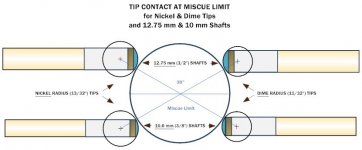The biggest disadvantage of having a flatter (or totally flat) tip on a break cue is you wouldn't get the benefit of automatic stroke-error correction that comes with having a rounded tip and your bridge length well matched to the natural pivot length of the cue. See cue natural pivot length for more information and supporting resources.I would be suspicious too. I don't think I've ever seen a flat tip on a break cue.
Regards,
Dave
Last edited:
